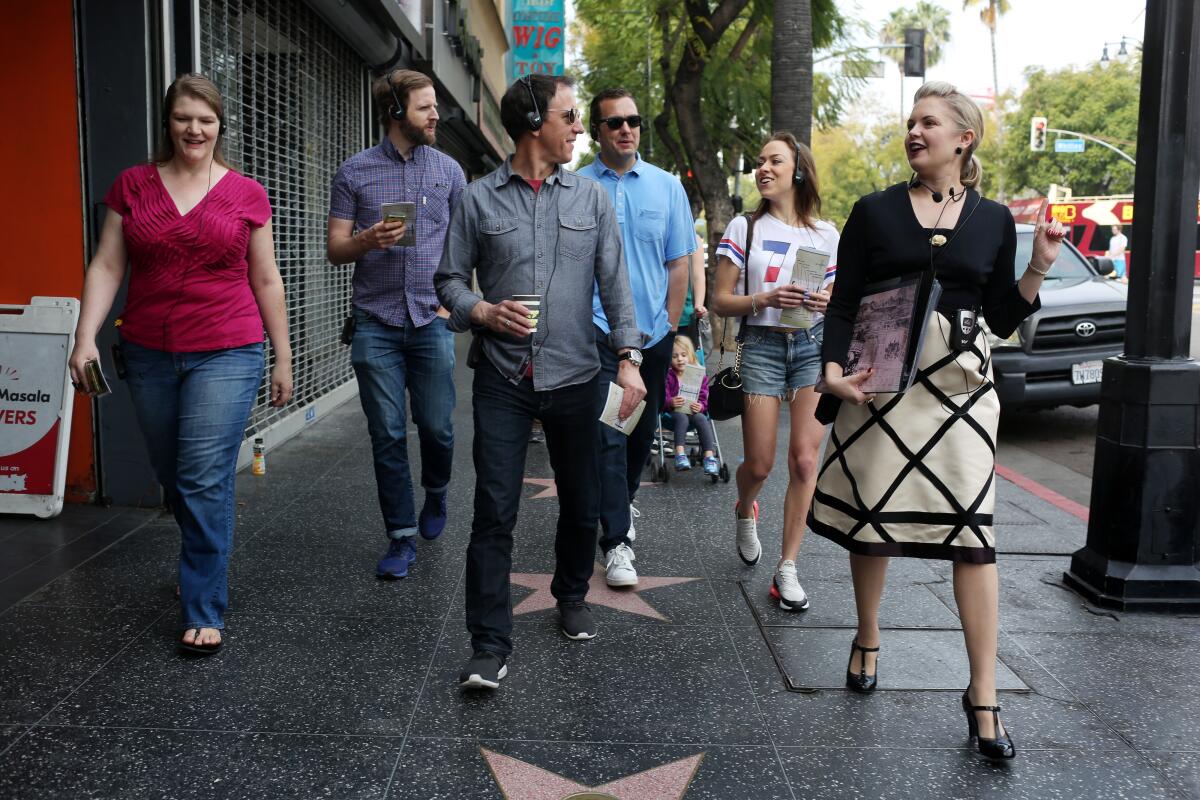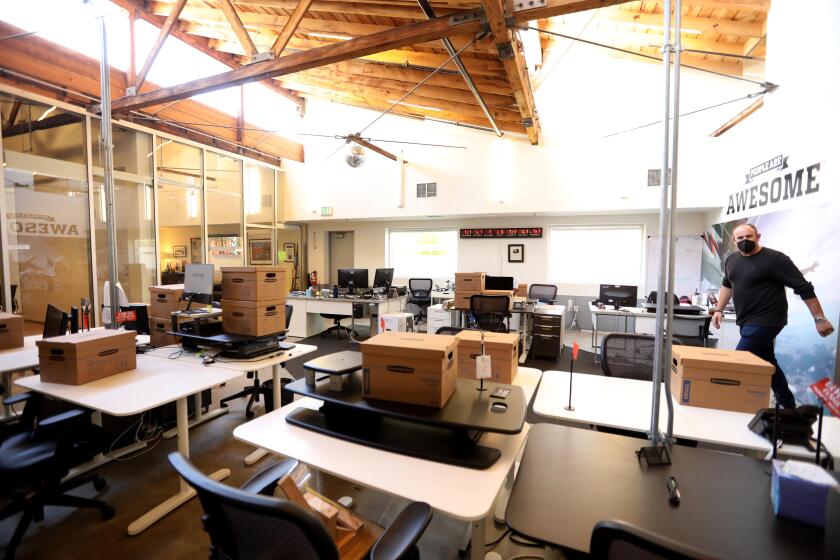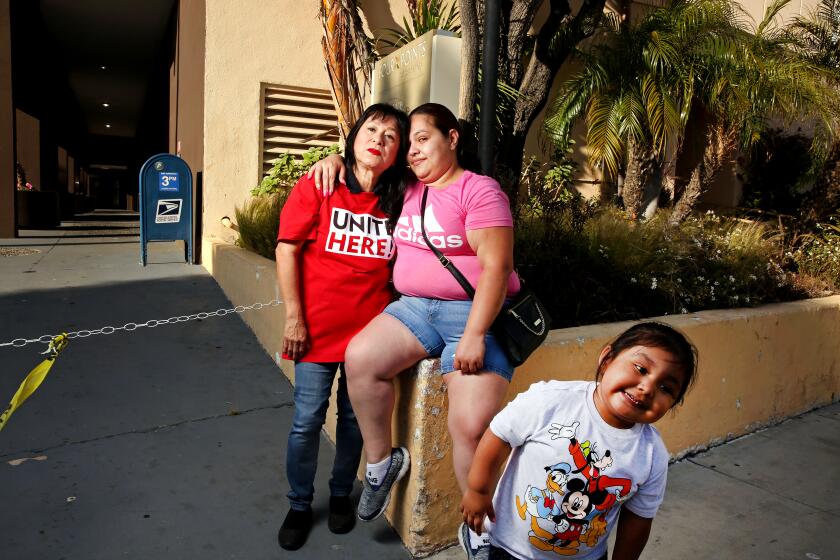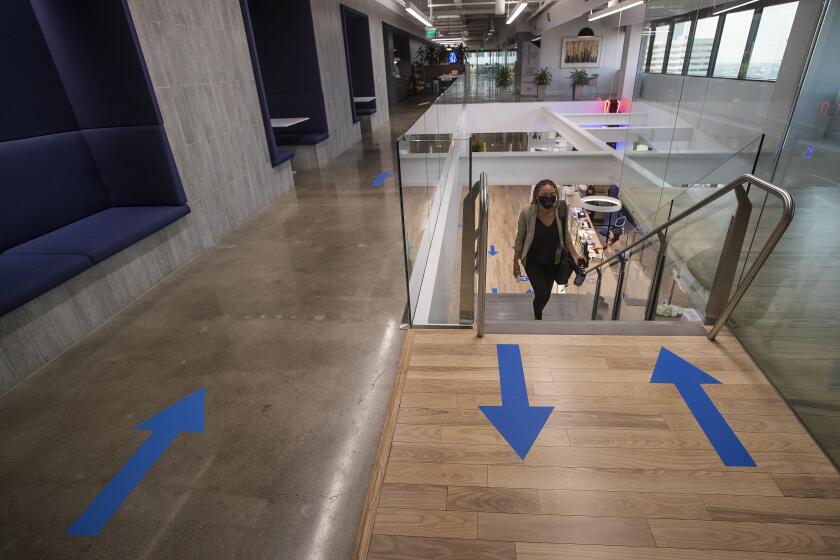California was ‘the locomotive’ of U.S. job growth in April, but it has a long way to go

- Share via
California accounted for an outsized portion of the nation’s new jobs last month, although its path to economic recovery from the pandemic remains steep.
“In April, California was the locomotive pulling the U.S. economy forward,” said Sung Won Sohn, a professor of finance and economics at Loyola Marymount University. The Golden State created 38% of the nation’s new jobs in April. But that was mainly due to the state emerging from a “lockdown harder and longer than in many parts of the country,” Sohn said.
California has a long way to go in recovering from its deep COVID-19 pandemic recession: More than half the jobs it lost have yet to return. The unemployment rate remained stagnant in April at 8.3%, the same as in March, state officials reported Friday.
Although the state’s job creation pace was comparatively robust in April, it slowed slightly from the previous month. Employers added 101,800 new positions last month for a total of more than 16.2 million. That was less than the 132,400 jobs added in March.
Nearly two-thirds of California’s job growth in the last three months was in the leisure and hospitality businesses that were most damaged during the pandemic. Their employment level remained 28% below the pre-pandemic level.
In Los Angeles County, which relies heavily on tourism, the economy remained in dire straits. Unemployment grew to 11.7% from 11.4% in March and more than half a million people were counted as out of work.
Come June 15, businesses in California can open their doors without COVID-19 constraints and fully vaccinated people can go mask-free in most situations.
“Los Angeles has been especially hard-hit by closures or severe limitations of such critical industries as hospitality, dining, travel, entertainment, and film production,” said Lynn Reaser, an economist at San Diego’s Point Loma Nazarene University.
The state’s jobless rate was the second highest in the nation in April, after Hawaii’s 8.5%. U.S. unemployment stood at 6.1% last month.
Year over year, California’s job growth has been slower than the nation’s; the state gained 8.7%, compared with 10.9% for the U.S.
Still, economists are growing more optimistic after Gov. Gavin Newsom announced the state’s economy should fully reopen by June 15. “California’s economy is ready to boom this summer when business restrictions are lifted,” Reaser said.
Pomona College economist Fernando Lozano suggested job creation was “moderate” last month because many schools were only partially open, child care was sparse and federal business loans had dried up. “Many households moved to more affordable areas, yet the jobs are reopening in the more expensive, urban communities,” he said.
Pepperdine University economist David M. Smith predicted the Golden State economy will achieve full employment by the fall. Despite geographical mismatches, “California is a jobs-producing machine,” he said. “Unemployment in the tech-dominated San Francisco is trending at less than half that of Los Angeles with its harder-hit small businesses, and entertainment and hospitality industries.”
The office beckons. What rights and protections do you have? Will safety and vaccine issues in the workplace prompt lawsuits?
Neel Sodha, the founder of LA Walking Tours, reduced the hours of his 13 guides during the pandemic. His company’s revenue remains half of what it was before the virus hit, despite easing COVID restrictions. “You would think that with the vaccines coming out and cases going down there would be more business,” he said. “That is not happening.”
Tourists remain leery of hanging out with strangers for a two-hour tour, and the limits on international travel are hurting business, he said. Before the pandemic, tourists from abroad represented about 20% of his clients. Now he rarely sees an international traveler, and about 90% of his customers are locals.
April Clemmer, owner of Old Hollywood Walking Tours, a one-woman enterprise, said her business dried up completely when the pandemic hit. She took down her reservation calendar and began giving virtual tours, during which clients could watch her presentation of 1930s Hollywood on their computer screens.
Private tours, which enable groups of family or friends to avoid the danger of walking close to strangers, also helped. Now with the virus abating, clients have begun to inquire about public tours. “I feel like it’s ticking back up again,” she said.
Clemmer is so optimistic that she is training a second tour guide to handle what she expects will be a summer surge.
The pandemic’s “shecession” could set back decades of progress on workplace equality, especially among Latina, Black and Asian women.
Statewide, April employment grew in seven of California’s broad industry sectors. The largest gain — 62,800 jobs in leisure and hospitality — was mainly driven by the reopening of full-service restaurants, officials said.
The professional and business services sector, which includes lawyers, accountants and technical specialists, added 19,000 positions. Payrolls in the “other services” sector, which includes hairdressers, auto repair shops and other miscellaneous businesses, grew by 10,500.
The largest loss was in the information sector, which shrank by 3,500 jobs, mainly in software publishing.
Los Angeles County payrolls added 34,600 jobs in April for a total of more than 4.14 million. The leisure and hospitality sector accounted for 58% of the new jobs. Positions in healthcare and social assistance grew by 6,000.
Orange County payrolls added 23,800 jobs for a total of more than 1.54 million. Leisure and hospitality accounted for 56% of the gain. Unemployment slid to 6.2% from 6.3% in March.
The Inland Empire, spanning Riverside and San Bernardino counties, added 6,700 payroll jobs for a total of more than 1.51 million. Leisure and hospitality accounted for 4,500 of the new jobs. Unemployment was 7.6%, down from 7.7% in March.
The employment data for April are based on two federal surveys taken in the second week of the month. Payroll job numbers are based on a survey of 80,000 California businesses. The unemployment rate comes from a separate survey of 5,100 households.
As COVID-19 recedes, California workers are being called back to the office. The office? Who remembers that place? And what will the return look like?
More to Read
Inside the business of entertainment
The Wide Shot brings you news, analysis and insights on everything from streaming wars to production — and what it all means for the future.
You may occasionally receive promotional content from the Los Angeles Times.














